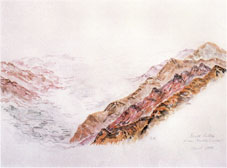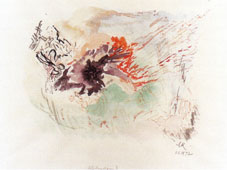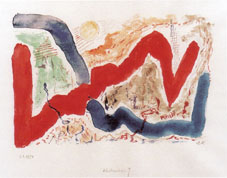| HOME | ARCHIV | BIBLIOGRAFIE | BIOGRAFIE |TEXTE | E-MAIL | |
|
ERNST KRENEKS WATERCOLORS
Krenek's interest in modern painters had nothing systematic. He pursued
random impressions. He owned a Maurice Utrillo reproduction, for example,
that, strangely enough, reminded him of Vermeer von Delft. Josef Albers,
who had emigrated after the Bauhaus had been closed and taught at the
Block Mountain College in North Carolina, gave him a trial print of
the black-and-white abstraction Edged II (1934) as a present.
And Paul Flora drew a Santa Fe Railroad comprising quotations
from his works an the occasion of his sixtieth birthday. Such encounters
were determined by personal contacts. Krenek has also left us a number
of observations with somewhat unfair exaggerations, such as his remarks
an the 'old-fashioned' Cuno Amiet or the 'lazy' Franz Wiegele. As his
autobiogrophy ends with his emigration, we have only little information
on his later contacts with American artists. Someone he really admired
was Oskar Kokoscha, who had been admitted to the Austrian Werkbund together
with him in 1933. Kokoschka portrayed Krenek as a young man bursting
with vitality. Krenek set Kokoschka's Orpheus and Eurydike to
music in 1923 (op. 21) and listened to OK's lantastic stories with his
mouth open. Krenek's paintings dating from the later decades of his life, which he has not described in any sequel to his memoirs, have something spontaneous and dashed off without any inner resistance. He did enjoy landscapes. He could not help comparing his new American home with Austria so that some of his 'doodlings' seem to have originated in memories - a notion that was not alien to him: he even called his 'musical doodlings' a 'means of escape', a 'facade' 'l had erected to disquise my inability for "real" life and to make me and others believe that I, being too busy fulfilling my responsibilities towards eternity, simply had no time for the trivialities of life.' (Im Atem der Zeit, 551) This is what he called his 'private version of the Freudian interpretation of art as a sublimation of the libido'. He was too harsh on himself in this regard. His work as a painter never resembles a 'facade' despite all its sketchy lightness. Looking for a common denominator that might also hold true for his musical and literary work, one will settle an this virtuoso lightness and 'bon goût' in the best sense of the word. He lacked the obsessive selfanalysis so typical for Arnold Schoenberg as a painter as well as an interest in other people he preferred to deal with in a literary manner. More than eighty watercolors and some drawings have survived. Besides the Landhof already mentioned and the Styrian Erzberg he painted on his way to the Venice Krenek Festival in 1960, there are no other Austrian subjects. As for American landscapes and the expanses of his new surroundings, Krenek was mainly interested in mountain ranges or valley views apart from topographical features like houses, beaches and highways that are, oddly enough, seen from the middle. There are also three works showing flowers and a patch of green. He has painted a number of landscapes an the outskirts (Tehachapi Mountain) and in the environs of Los Angeles such as the Colorado Desert area south of Palm Springs and several views of the Anza Borrego National Park and the Salton Sea. Other inhospitable sites were Death Valley west of Las Vegas and the Colorado River south of the gambling town.
Death Valley from Dante's View, watercolor, April 1972
Though he probably also visited the Grand Canyon an his way to Arizona
and Utah, Krenek apparently did not paint this spectacular landscape.
He was especially interested in remote and snowy peaks like those of
the White Mountains in Nevada. He undertook several travels into the
Rocky Mountains and the Sangre de Cristo Mountains which he had seen
for the first time when being invited to deliver guest lectures at various
universities in New Mexico in the late forties. There are various versions
of a San Antonio Mountain, though one not in California but in
Mexico near Duarte. In some cases, Krenek was not only interested in
the topographical features but also in the atmosphere. Death Valley
fades in the haze, and in Storm over Borrego a sunbeam breaks
through the clouds. In two other paintings, the moon shines like a pumpkin
above the volley bathed in violet light (Moon There is no stylistic development. Krenek did not orient himself by
current trends in art. He did not imitate any artists, not even Kokoschka,
but took up his brush without a specific claim. Yet, there is something
his endeavors do have in common. Krenek abstains from filling the paper,
and his compositions have no boundary or frame, i.e. he never reaches
the upper or lower margin, while the horizon might continue to the left
and to the right like a panorama. His strokes are small and precise,
and yet he never loses his verve regarding the structure of the whole.
He makes use of the entire range of colors. Mostly, he adds the place
and date next to his signature initials EK with a pencil in the right-hand
corner at the bottom; about thirty works da not display an inscription.
Krenek did not really paint much at any period of his life. While he
finished up to ten works in some years, he did not find any time to
paint in others. In the middle and in the late fifties, he did more
watercolors than at any other time of his life. He devoted time to his
painting especially in the summer months, in July and August, and during
Christmas. Abstraction 3, watercolor, January 1972
Abstraction 7, watercolor, January 1974 |
|
|
|
|

 radiating
like a star becomes an energy center that sprays red embers to the right
and blows black and gray ashes towards the upper left-hand side. There
is also a blurred pair of small scissors that might serve as an instrument
for cutting up this area. Also reminiscent of the gestural painting
of Informel in the fifties, Abstraction 3 is to be considered
the most interesting composition of the series from the point of view
of painting.
radiating
like a star becomes an energy center that sprays red embers to the right
and blows black and gray ashes towards the upper left-hand side. There
is also a blurred pair of small scissors that might serve as an instrument
for cutting up this area. Also reminiscent of the gestural painting
of Informel in the fifties, Abstraction 3 is to be considered
the most interesting composition of the series from the point of view
of painting.